#Food Photographer in haryana
Text
Stylist Food photographer in Haryana | Manish Rajput

Manish Rajput Photography is the best food photography in Rohtak, Haryana, and that too very lowest price. We are specialists in food photography because we are doing food photography from 7 years. We have a professional photographers team and hundreds of customers trust us for our good work, and they increase their sales and orders. So why are you waiting for? Just call at:9891871419
#professional Food photographer in Rohtak#Food Photographer in Haryana#Best food photographer in Rohtak Haryana
0 notes
Text
Name of Post:
Haryana HPSC HCS Civil Services Online Form 2023
Post Date:01 December 2023 @ 10:01PMShort Information :Haryana Public Service Commission (HPSC) has Recently Invited to the Online Application Form for the Post Civil Services Examination Recruitment 2023.
Haryana Public Service Commission (HPSC)
HPSC HCS Civil Services Recruitment 2023
Advt. No.58/2023
Important Dates
Start Date: 01/12/2023
Last Date : 21/12/2023
Pre Exam Date : 11 February 2024
Mains Exam Date : 30, 31 March 2023
Application Fee
General / EWS :Rs. 1000/-
SC/ BC/ ESM : Rs. 250/-
Haryana Female : Rs. 250/-
PH Candidates: Rs. 0/-
You can pay through:
Credit Card
Debit Card
Net Banking
UPI
Age Limit as on ( 01/01/2023)
Minimum. Age : 18 Yrs.
Maximum. Age : 27 Yrs. (DSP)
Maximum. Age : 42 Yrs. (Other)
Age Relaxation read the notification.
Eligibility Criteria
Bachelor Degree in Any Stream From Recognized University in India.
Vacancy Details
Total Post : 121 Post
Physical Eligibility ( DSP Post)
Sr.NoGenderHeightChestChest with Expansion01Male5'7" (170.18 cm)82.82 cm87.63 cm02Female5'2" (157.50 cm)N/AN/A
Selection Process
Preliminary Written Exam (200 Marks)– Qualifying
Mains Written Exam (600 Marks)
Personality Test/ Interview (75 Marks)
Document Verification
Medical Examination
HPSC Pre Exam : Offline
SubjectQuestionsMarksTimeGeneral Studies1001002 HoursCivil Services Aptitude Test (CSAT)- Qualifying1001002 Hours
HPSC Mains Exam Pattern : Descriptive
Paper No.SubjectMarksTimePaper-IEnglish (Including Essay)1003 HoursPaper-IIHindi (Including Essay)1003 HoursPaper-IIIGeneral Studies2003 HoursPaper-IVOptional Subject2003 HoursHPSC HCS Salary OverviewName of the PostsHCS Pay ScaleHCS Pay LevelHCS Grade payBasic SalaryIn-hand salary (Approx.)HCS Executive BranchINR 15,600 to INR 39,100FPL-10INR 5,400INR 56,100INR 69,000 to INR 75,000Deputy Superintendent of PoliceINR 9,300 to INR 34,800Level-9INR 5,400INR 53,100INR 66,000 to INR 71,000Excise and Taxation OfficerINR 9,300 to INR 34,800Level-9INR 5,400INR 53,100INR 66,000 to INR 71,000District Food & Supplies ControllerINR 9,300 to INR 34,800Level 9(1)INR 4,600INR 44,900INR 57,000 to INR 61,000'A' Class TehsildarINR 9,300 to INR 34,800Level 09INR 4,600INR 44,900INR 57,000 to INR 61, 000Assistant Registrar Cooperative SocietiesINR 9,300 to INR 4,800Level 09INR 4,600INR 44,900INR 57,000 to INR 61,000Assistant Excise and Taxation OfficerINR 9,300 to INR 34,800Level-7INR 4,600INR 44,900INR 57,000 to INR 61,000Block Development and Panchayat Officer (BDPO)INR 9,300 to INR 34,800FPL-7INR 4,600INR 44,900INR 57,000 to INR 61,000Traffic Manager (TM)INR 9,300 to INR 34,800FPL-7 (I)INR 4,600INR 44,900INR 57,000 to INR 61,000District Food & Supplies Officer (DFSO)INR 9,300 to INR 34,800FPL-7 (I)INR 4,600INR 44,900INR 57,000 to INR 61,000Assistant Employment Officer or AEOINR 9,300 to INR 34,800FPL-7 (I)INR 4,600INR 44,900INR 57,000 to INR 61,000
Required Documents
Candidates Photograph
Candidates signature
How To Apply
These are following step.
Click on the Apply Online Link given below.
Fill out the application form.
Upload the required documents
Pay Fees
Print the Application Form.
USE IMPORTANT LINKS
Apply Online
0 notes
Text
Car On Rent In Delhi To Amritsar Chandigarh
Amritsar
Udan Travel IND Service provides Toyota Etios, Swift Dzire, Ertiga, Mahindra Xylo, Toyota Innova, and Crysta Car on rent in Delhi To Amritsar Tour package. Book an online Car from Delhi to Amritsar Punjab Trip. We Provide 4, 5, 6, 7 Seater Luxury Car Rent in Delhi To Amritsar Tour
Amritsar is a vibrant and culturally rich city located in the Indian state of Punjab. It is known for its historical significance, spiritual attractions, and delicious cuisine. Here are some of the top tourist places to visit in Amritsar:
Golden Temple (Harmandir Sahib): The Golden Temple is the holiest site in Sikhism and one of the most iconic landmarks in India. The temple is made of marble and overlaid with real gold leaf, giving it its distinctive appearance. The serene lake surrounding the temple, known as the Amrit Sarovar, adds to its beauty. Visitors can also partake in the Langar, a community meal that is served to all, regardless of their religion or background.
Jallianwala Bagh: This historical site is known for the tragic Jallianwala Bagh massacre of 1919, where British troops killed hundreds of unarmed Indian civilians. The site has been preserved as a public garden and a memorial to the victims. You can see the bullet marks on the walls and a Martyrs' Well.
Wagah Border: Located on the India-Pakistan border, Wagah Border is famous for its daily evening Beating Retreat Ceremony. This elaborate and energetic military ceremony is a symbol of the rivalry and cooperation between the two nations.
Durgiana Temple: Also known as the Lakshmi Narayan Temple, it is a beautiful Hindu temple built in the architectural style of the Golden Temple. It is dedicated to the Hindu goddess Durga and is a peaceful place of worship.
Partition Museum: This museum provides insights into the tragic events of the Partition of India in 1947. It houses a collection of personal stories, photographs, and artifacts related to this historic event.
Maharaja Ranjit Singh Museum: Located in Ram Bagh Park, this museum is dedicated to the life and achievements of Maharaja Ranjit Singh, the founder of the Sikh Empire. It showcases his personal belongings, weapons, and art.
Gobindgarh Fort: This historic fort has been recently renovated and opened to the public. It offers a glimpse into the history of the region and features museums, cultural shows, and a live demonstration of a traditional Punjabi wedding.
Mata Temple (Mata Lal Devi Temple): This temple is dedicated to the Hindu goddess Lal Devi. The architecture of the temple is unique, and it's known for its colorful and ornate interiors.
Rambagh Garden: A beautiful garden complex with a central marble pavilion. It's a great place to relax and enjoy some leisure time.
Amritsar Heritage Street: This pedestrian-friendly street offers a range of traditional Punjabi food, handicrafts, and cultural experiences. It's an excellent place to explore the local culture and cuisine.
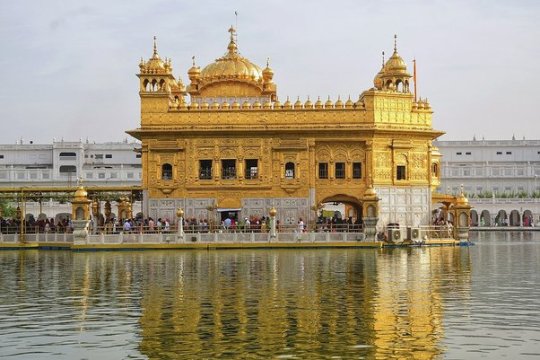
Amritsar is not just a city with historical and spiritual significance but is also famous for its delicious Punjabi cuisine, including dishes like Amritsari Kulcha, Chole Bhature, and various types of kebabs and sweets. Make sure to savor these culinary delights while visiting the city.
Chandigarh
Udan Travel IND Service provides Toyota Etios, Swift Dzire, Ertiga, Mahindra Xylo, Toyota Innova, and Crysta Car on rent in Delhi To Chandigarh Tour package. Book an online Car from Delhi to Chandigarh Punjab Trip. We Provide 4, 5, 6, 7 Seater Luxury Car Rent in Delhi To Chandigarh Tour
Chandigarh, the capital of the Indian states of Punjab and Haryana, is known for its modern architecture, well-planned layout, and lush greenery. There are several tourist attractions in and around Chandigarh that you might want to explore:
The Rock Garden of Chandigarh: This unique garden is entirely made of recycled industrial and urban waste, and it's a testament to human creativity. It features numerous sculptures, mosaics, and art pieces made from discarded materials.
Sukhna Lake: A man-made reservoir, Sukhna Lake is a popular spot for leisurely walks, boating, and picnics. The lake is surrounded by a beautiful promenade and the Shivalik hills in the backdrop.
Rose Garden (Zakir Hussain Rose Garden): This is one of Asia's largest rose gardens, home to thousands of rose bushes. The garden is a fragrant paradise with a variety of roses on display.
Le Corbusier Centre: Chandigarh is known for its modernist architecture, and this center is dedicated to the renowned architect Le Corbusier, who designed the city. It showcases his work and contributions to the city's planning.
Capitol Complex: Another masterpiece by Le Corbusier, the Capitol Complex houses the legislative assembly, high court, and secretariat. The unique architectural design is a UNESCO World Heritage Site.
Nek Chand's Rock Garden: Apart from the Rock Garden mentioned earlier, there's also a smaller garden created by Nek Chand, the same artist who created the larger Rock Garden. It features figurines made from waste material and recycled items.
Government Museum and Art Gallery: This museum has a vast collection of art, sculptures, and artifacts. The highlight is the miniature paintings section, which houses some exquisite pieces of Indian art.
Chhatbir Zoo: Also known as the Mahendra Chaudhary Zoological Park, it's located about 20 km from Chandigarh and is home to a wide range of animal species.
Pinjore Gardens (Yadavindra Gardens): Located in the nearby town of Pinjore, these historic gardens have terraced lawns, fountains, and beautifully landscaped gardens.
Cactus Garden: Asia's largest outdoor cactus garden, it's home to a stunning variety of cacti and succulent plants.
Morni Hills: About an hour's drive from Chandigarh, Morni Hills offers a serene escape with its scenic landscapes, lakes, and opportunities for trekking and bird-watching.
Adventure Activities: You can also engage in various adventure activities near Chandigarh, such as rock climbing, trekking, and paragliding in the Shivalik foothills.

Chandigarh is not only a well-planned city but also a place where art, culture, and nature coexist harmoniously. Whether you're interested in modern architecture, gardens, or outdoor activities, you'll find something to enjoy in this city.
#luxury car hire in delhi to amritsar#delhi to amritsar taxi service#car on rent in delhi to amritsar#delhi to amritsar cab rental#car booking delhi to amritsar#car rent in delhi to amritsar#cheapest taxi on rent in delhi to amritsar#taxi on rent in delhi to amritsar#cab service on rent in delhi to amritsar#luxury car hire in delhi to chandigarh#delhi to chandigarh taxi service#car on rent in delhi to chandigarh#delhi to chandigarh cab rental#car booking delhi to chandigarh#car rent in delhi to chandigarh#cheapest taxi on rent in delhi to chandigarh#taxi on rent in delhi to chandigarh#cab service on rent in delhi to chandigarh
0 notes
Text
The Hidden World of India’s Wild Felines | Think Wildlife Foundation
India is a land of diverse wildlife and the home to some of the most magnificent and unique animal species. India has at least 15 species of wild felines which is the highest in the world and they differ in size, habitat, diet and body shape. Let us explore and learn about India’s wild felines. We will start with the lesser known species.
youtube
1. Asiatic Caracal

Diet- Rodents like Hares, Birds, Reptiles, and even young ones of gazelles.Critically Endangered in India
Habitat- Dry and shrublands, grasslands and semi-desert habitat.
Distribution- In India, their presence from photographic evidence has only been recorded in the states of Rajasthan, Gujarat and Madhya Pradesh. Habitat loss, Lack of research and knowledge.
2. Rusty Spotted Cat

Diet- Rodents, Birds, Lizards, Frogs and large insects. IUCN Status- Near Threatened.
Habitat- Prefer deciduous forest with dense vegetation and rocky area.
Distribution- In India, they have a big range. They are mostly observed in Southern and Central Indian states but have been sighted in Northern states of Haryana and Uttar Pradesh as well. Habitat loss & Spread of cultivation, occasionally hunted for food or as livestock pests.
Pallas’ Cat
Given the title of the ‘grumpiest cat in the world’ due to its look, Palla’s cat is a small sized cat with heavy and dense grey coloured fur. They are adapted to life in cold snowy mountainous regions.
Diet- Voles, Pikas, Lizards and Birds.
IUCN Status- Least Concern
Habitat- Mountainous and snowy terrain. Distribution- In India, it is found in Ladakh, Sikkim and Uttarakhand. Threats- Habitat fragmentation, habitat loss, feral dogs and poaching.
4. Eurasian Lynx.

Diet- Hares, Boars and small ungulates like goats.
IUCN Status- Least Concern
Habitat- Mountainous and snowy terrain.
Distribution- In India, it has been sighted in Ladakh, Sikkim and Himachal Pradesh
Threats- Habitat loss and fragmentation, poaching and depletion of prey base.
5. Fishing Cat
Larger than any other small cat, the fishing cat is the only feline which has adapted to a life in water. Short legs, deep chest and short stubby tail differ them from other feline species. Their body is brownish with light spots which perfectly camouflage in the muddy water of mangroves. They dive their head first, catching the fish off guard and then bringing it off shore where they enjoy their meal. They are primarily nocturnal.
Diet- Majorly fishes, other aquatic animals and waterbirds.
IUCN Status- Vulnerable
Habitat- Mangroves and wetlands
Distribution- In India, its range includes the states of West Bengal, Orissa and Andhra Pradesh
Threats- Habitat loss, pollution of water bodies and overexploitation of natural fish stock.
6. Marbled Cat
Named after the beautiful and distinctive marbling pattern on their brownish coat, Marbled cats are small sized felines who are arboreal in nature i.e. they are adapted to life on trees. They have well rounded ears and a cylindrical tail as long as their body which helps in counterbalancing. Being incredibly shy and elusive, these felines are hard to observe, thus not a lot is known about them.
Diet- Squirrels, Fruit bats, Birds and Rodents. IUCN Status- Near Threatened.
Habitat- Foothills of Himalayas, in the evergreen and moist deciduous forests. Distribution- Forest of the North-eastern states.
Threats- Deforestation, indiscriminate snaring and poaching.
7. Clouded Leopard
They have large dusky-grey blotches and irregular spots and stripes reminiscent of clouds giving them the name of ‘Clouded Leopard.’ Of any feline in the world, they have the largest canine to body ratio. Even though they are arboreal in nature, most of the hunts take place in the forest floor. Tail is long to support tree climbing and to maintain balance. Like most other felines, they are also nocturnal.
Diet- Birds,monkeys, and small deer species like the barking deer and the hog deer.
IUCN Status- Vulnerable.
Habitat- Foothills of Himalayas, in the evergreen and moist deciduous forests. Distribution- Forest of the North-eastern states.
Threats- Deforestation, habitat fragmentation and poaching.
8. Leopard Cat
Around the size of a domestic cat but more slender, the leopard cats have a wide variety of colour coats and coat markings. Two subspecies can be so different from each other in looks that one may think of it as two completely different species. The subspecies found in India has a pale silver grey coat with black spots or rosettes. They are the most widely found small cat in the continent of Asia.
Diet- Small rodents like mice and shrew, birds and small reptiles.
IUCN Status- Least Concern.
Habitat- Highly adaptable. Can be found in subtropical deciduous and coniferous forests as well as in agricultural plantations.
Distribution- Two different populations are said to exist in India; one in north and north-eastern part and other in western ghats.
Threats- Hunting and poaching.
Diet- Larger rodents, birds, reptiles and small ungulates
IUCN Status- Near Threatened.
Habitat- Inhabits deciduous, tropical and subtropical forests.
Distribution- North- Eastern states of India.
Threats- Habitat destruction, deforestation, reduction in prey base.
10. Asiatic Wild Cat / Indian Desert Cat

Diet- Desert gerbils, hares, birds, reptiles and eggs of ground birds.
IUCN Status- Not much information but the population is thought to be declining.
Habitat- Shrublands, desert and semi desert regions.
Distribution- Common in the desert and semi-desert region of Rajasthan, have also been sighted in Madhya Pradesh and Uttar Pradesh.
Threats- Hybridisation with domestic cats, revenge killing for poultry.
11. Jungle Cat
Diet- Mainly rodents, Hares, birds, reptiles and frogs, occasionally fruits.
IUCN Status- Least Concern.
Habitat- Swamps, wetlands,littoral areas, grasslands and shrublands, can often be sighted near human settlement.
Distribution- Most common small wild cat of India.
Threats- Habitat loss, revenge killing for poultry.
12. Snow Leopard
Diet- Marmots, Himalayan Blue sheep, Himalayan Tahr and wild goats.
Status- Critically Endangered in India.
Habitat- Snowymountain range of the Himalayas.
Distribution- Jammu & Kashmir, Ladakh, Uttrakhand, Himachal Pradesh, Sikkim and Arunachal Pradesh.
Threats- Shrinking habitat, Global warming, poaching and illegal trade.
13. Asiatic Lion
Diet- Chital, Sambar deer, Nilgai and livestock.
IUCN Status- Endangered.
Habitat- Dry deciduous forests, scrublands and grasslands.
Distribution- Currently only home is Gir WS in Gujarat.
Threats- Small gene pool, inbreeding and heavy concentration in only one area risks to wiping out of the species in case of any epidemic
14. Indian Leopard
Most widely found species of big cat in India, the Indian leopard has it all to succeed in most of the habitats. They are extremely adaptable, with many living around human settlements. Body is yellow in colour, the belly region is white and the whole body is marked with black rosettes. They are mostly nocturnal and live solitary lives. They are well known to carry their prey to a tree branch where it is protected from other predators.
Diet- They are fairly adaptable and prey on a variety of species. Common prey are Chital, Sambar and livestock.
IUCN Status- Vulnerable.
Habitat- Evergreen forests, Moist and dry deciduous and semi-arid regions.
Distribution- Found in most of India except high altitude.
Threats- Habitat loss, human-animal conflict, poaching and road accidents.
15. Royal Bengal Tiger
The most famous and well known cat of India is the Tiger. The body coat is yellow to light orange which is covered in black strips. The pattern of these stripes differ from tiger to tiger. They are the apex predator in most of the Indian forests. They prefer to live alone, mother raises the cubs by herself. Once they were near extinction but conservation efforts by the Indian government has ensured a healthy and sizable population in India.
Diet- Deers, Nilgai, Monkeys and subadult Gaurs.
IUCN Status- Endangered.
Habitat- Evergreen and Deciduous forests
Distribution- Widely distributed in India, found in most of the states.
Threats- Habitat loss, Human-tiger conflict and poaching
Apart from these 15 cats, India do have the common domestic cat and now cheetahs have also been controversally reintroduced.
We at Think Wildlife Foundation recently launched our Livelihoods for Conservation project to provide alternative, sustainable livelihoods to the communities living with wildlife. This is with the aim to incentivize conservation while uplifting these communities economically. You can purchase merchandise from these communities here!
Written by: Samarth Jain
Originally published at https://thinkwildlifefoundation.com on June 24, 2023.
0 notes
Text
Kira hit Kaur, far left, came to the Tikri protest site from Talwandi, Punjab, on Feb. 23 with a group of 20 women, including her mother-in-law and children. “It is important for all women to come here and mark their presence in this movement. I have two daughters, and I want them to grow up into the strong women they see here.”
TEXT BY NILANJANA BHOWMICK | PHOTOGRAPHS BY KANISHKA SONTHALIA FOR TIME
MARCH 4, 2021 9:00 PM EST
The message to women was clear: Go back home. Since November, hundreds of thousands of farmers had gathered at different sites on the outskirts of the Indian capital to demand the repeal of three agricultural laws that they say would destroy their livelihoods. In January, as the New Delhi winter set in, the Chief Justice of India asked lawyers to persuade elderly people and women to leave the protests. In response, women farmers—mostly from the rural states of Punjab, Haryana and Uttar Pradesh—scrambled onto stages, took hold of microphones and roared back a unanimous “No!”“Something snapped within us when we heard the government tell the women to go back home,” says Jasbir Kaur, a sprightly 74-year-old farmer from Rampur in western Uttar Pradesh. It’s late February and Kaur has been camping at the Ghazipur protest site for over three months, only returning home once. She was stung by the court’s suggestion that women were mere care workers providing cooking and cleaning services at these sites—though she does do some of that work—rather than equal stakeholders. “Why should we go back? This is not just the men’s protest. We toil in the fields alongside the men. Who are we—if not farmers?”
Questions like this have rarely been asked by women like Kaur, long used to having their contributions to farming overlooked as part of their household duties. But this wave of protests—the world’s largest ongoing demonstration and perhaps the biggest in human history—has prompted thousands to make their voices heard. Indians of all ages, genders, castes and religions have been united by a common goal: to roll back new agricultural laws passed in September by Prime Minister Narendra Modi’s government. The laws, suspended in January by the Supreme Court but not yet repealed, would allow private corporations to buy directly from farmers, which they say would leave them at the mercy of buyers and do away with the traditional wholesale market system or mandis, where they are assured a minimum set price for certain crops.
Women, who form the backbone of Indian agriculture, may be particularly vulnerable to corporate exploitation. According to Oxfam India, 85% of rural women work in agriculture, but only around 13% own any land. “Women are not seen as farmers. Their labor is immense but invisible,” says Jasbir Kaur Nat, a member of the Punjab Kisan Union, who is mobilizing farmers in Tikri, the protest site at the border of Haryana and Delhi.....see rest of article
This story is not getting enough press in American media even though this can impact the human rights of so many people and threaten the food supply of many others
46 notes
·
View notes
Text
Travel through Amritsar to see the Golden Temple by Cab!
(The holiest place of the Sikh community, but with doors open for all the tourists without any discrimination, Amritsar is a town where an aura of satisfaction revolves. Read on to know more)
Based and the founder of this town Ram Das, the Fourth Sikh Guru, Amritsar, was founded in the year 1577. Famous all around the world, The Golden Temple is the pride of Amritsar. The Golden Temple is a Sikh Temple but visited by all communities with faith and hope. An anesthetic and serene atmosphere is what you can expect while you roam in a cab in Amritsar!
Places to visit in Amritsar

The Golden Temple
Without any doubt, the Golden Temple is the prime attraction of tourists in Amritsar. The temple is adorned with real gold and rests in a manmade lake. It is the ultimate pilgrimage spot for the Sikhs, who believe that they should visit the Golden Temple at least once in their lifetime.
Wagah Border Ceremony
One of the goose-bump-giving experiences every Indian should attend is the Wagah Border Beating Retreat Ceremony. A sense of patriotism automatically comes in when you attend this function which is held every day in the evening.
Partition Museum
A collection of newspaper articles, speeches, old photographs, and a lot more antiques all related to the Partition of India and Pakistan can be seen here.
Jallianwala Bagh
The Jallianwala Bagh Massacre holds a lot of importance for the struggle for India’s Independence. An eternal flame torch is seen near the Martyr’s Gallery and a monument built in the respect and bravery of all the freedom fighters who were victims of this massacre. The bullet holes in the walls are still kept intact, which signifies the historical importance.
Other places to visit in Amritsar are Shri Durgiana Mandir, Khalsa College for its architecture, Ram Bagh Gardens, Baba Atal Tower, and a lot of other monuments of historical and religious significance.
To visit these tourist spots the best way of transport is Car rental in Amritsar, which is an easy and cost-saving mode.
Places To Visit Around Amritsar
Jalandhar — The Sports City of India
Ludhiana — The largest city of Punjab
Pathankot — The Boundary shared with Pakistan
Chandigarh — The joint capital of Punjab and Haryana
Dharamshala — The Tibetan Culture in India
Dalhousie — An outstanding hill station for romantic dates and family vacations
Shimla — The most popular hill station of India
Rishikesh — The most sacred city of India
Amritsar is well connected to these cities via road routes. You can, any day, have a car on rent in Amritsar to visit these cities for a short vacation. All the routes have unmatched scenic beauty all around.

Food in AmritsarThe first thing that strikes us when we say food in Amritsar is the langar of the Golden Temple. Cooked and helped by devotees themselves, where anyone can come to eat food, and everyone is treated with equal respect. The Golden Temple Langar makes meals for around 1,00,000 diners every day. The dal, roti, sabzi, and kheer are well known as the Langar ka Prasad.
The famous Amritsari Kulchas, which are served with Chana Sabji, onions, and chutney.
The well–known dhabas at Amritsar like Friends Dhaba, Pal da Dhaba, Kesar da Dhaba, and many more.
A refreshing Punjabi Lassi is a must-try when you visit Amritsar.
Shopping in AmritsarLahori Gate Market — A bargaining hub for ladies’ wear and Pashmina Shawls. It is also a taste relief experience in this market, wherein you can buy papads, pickles, and homemade jams.
Katra Jaimal Singh Bazar — Another bargain shopping hub of Amritsar, you can buy footwear, woodwork, jewelry, and handicraft items.
Hall Bazar — The oldest market of Amritsar, famous for phulkari design dresses and lamps. The architecture of this bazaar is worth a watch too.
Apart from these major three, you can go on a shopping spree at Lawrence Road, Shastri Market, Kapda Bazar, and the old city Bazar.
Mode of Transport in AmritsarAuto–rickshaws and cycle rickshaws are the most common mode of transport in Amritsar as it is a small town. Apart from this, you can book a cab in Amritsar to go around the town and enjoy the scenic beauty along with sightseeing places, shop as much as you want and eat till you are satisfied!ConclusionA town of high significance when it comes to religious and historical stories. A small town with a big heart is what we can sum up Amritsar to be! Nobody sleeps empty stomach, and neither does one sleep without any shed. With scenic beauty all around, Amritsar is a perfect vacation and pilgrimage hub for tourists of all communities and all age — groups!
#taxiserviceinamritsar#cabserviceinamritsar#carrentalserviceinamritsar#carhireinamritsar#outstationscabsinamritsar#cabinamritsar#caronrentinamritsar
2 notes
·
View notes
Text
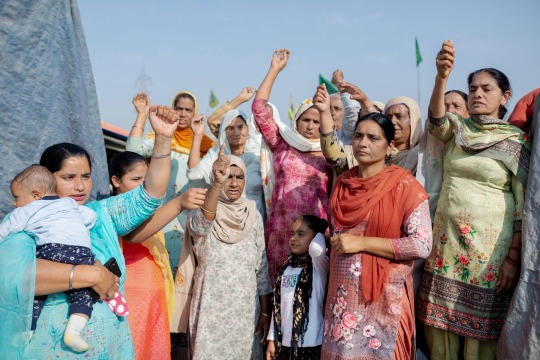
Kiranjit Kaur, far left, came to the Tikri protest site from Talwandi, Punjab, on Feb. 23 with a group of 20 women, including her mother-in-law and children. “It is important for all women to come here and mark their presence in this movement. I have two daughters, and I want them to grow up into the strong women they see here.” Kanishka Sonthalia for TIME
WORLD INDIA
'I CANNOT BE INTIMIDATED. I CANNOT BE BOUGHT.' THE WOMEN LEADING INDIA’S FARMERS’ PROTESTS
— Text By Nilanjana Bhowmick | Photographs By Kanishka Sonthalia For TIME | MARCH 4, 2021 | TIME Magazine
The message to women was clear: Go back home. Since November, hundreds of thousands of farmers had gathered at different sites on the outskirts of the Indian capital to demand the repeal of three agricultural laws that they say would destroy their livelihoods. In January, as the New Delhi winter set in, the Chief Justice of India asked lawyers to persuade elderly people and women to leave the protests. In response, women farmers—mostly from the rural states of Punjab, Haryana and Uttar Pradesh—scrambled onto stages, took hold of microphones and roared back a unanimous “No!”
“Something snapped within us when we heard the government tell the women to go back home,” says Jasbir Kaur, a sprightly 74-year-old farmer from Rampur in western Uttar Pradesh. It’s late February and Kaur has been camping at the Ghazipur protest site for over three months, only returning home once. She was stung by the court’s suggestion that women were mere care workers providing cooking and cleaning services at these sites—though she does do some of that work—rather than equal stakeholders. “Why should we go back? This is not just the men’s protest. We toil in the fields alongside the men. Who are we—if not farmers?”
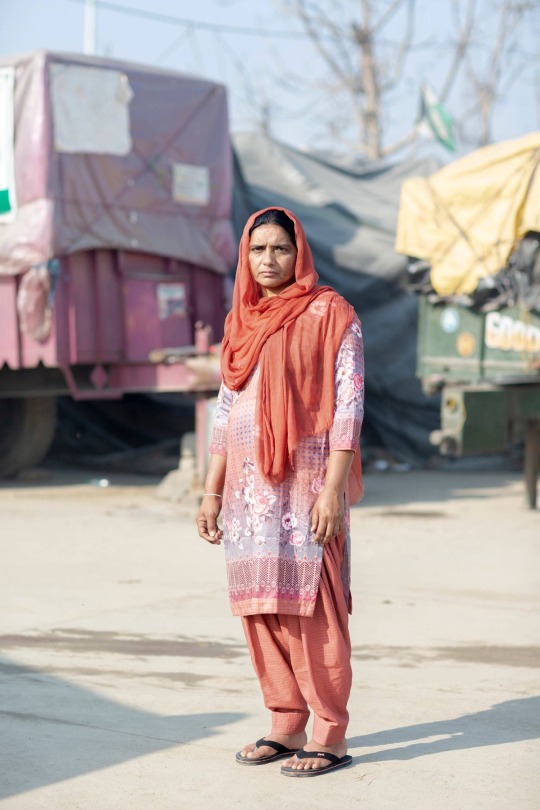
Amandeep Kaur, 41, from Talwandi, Punjab, is employed as a community health worker and as a farmer to support her two daughters. Her husband died by suicide five years ago; because she did not know her rights, she didn’t receive government compensation given to families of farmers who die by suicide. The new laws, she says, “will kill us, will destroy what little we have.” Kanishka Sonthalia for TIME
Questions like this have rarely been asked by women like Kaur, long used to having their contributions to farming overlooked as part of their household duties. But this wave of protests—the world’s largest ongoing demonstration and perhaps the biggest in human history—has prompted thousands to make their voices heard. Indians of all ages, genders, castes and religions have been united by a common goal: to roll back new agricultural laws passed in September by Prime Minister Narendra Modi’s government. The laws, suspended in January by the Supreme Court but not yet repealed, would allow private corporations to buy directly from farmers, which they say would leave them at the mercy of buyers and do away with the traditional wholesale market system or mandis, where they are assured a minimum set price for certain crops.
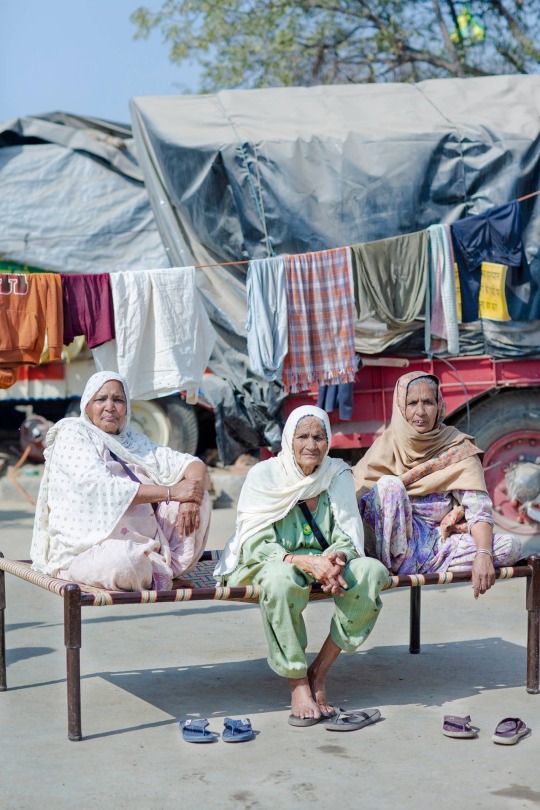
The protests have drawn women of all ages. While some speak onstage, others are simply determined to be present. “I am an illiterate woman,” says Gurmer Kaur, center, at the protests with her friends Surjit Kaur, left, and Jaswant Kaur, right, all in their mid-70s. “I cannot talk well, but I can sit tight—and I will sit here till the next elections if these laws are not called off.” Kanishka Sonthalia for TIME
Women, who form the backbone of Indian agriculture, may be particularly vulnerable to corporate exploitation. According to Oxfam India, 85% of rural women work in agriculture, but only around 13% own any land. “Women are not seen as farmers. Their labor is immense but invisible,” says Jasbir Kaur Nat, a member of the Punjab Kisan Union, who is mobilizing farmers in Tikri, the protest site at the border of Haryana and Delhi.

Photograph by Kanishka Sonthalia for TIME
“This law will kill us, will destroy what little we have,” says Amandeep Kaur, a farmer from Talwandi in Punjab, whose husband died by suicide five years ago, following a bad crop that landed him with a debt of around $7,000. As well as farming, Kaur works as a community health worker to support her family; she and her two daughters only got rights to the land after her husband’s death. She lost out on compensation of almost the same amount that the Indian government gives to families of farmers who die by suicide because she did not secure a post mortem of the body to certify the death as suicide. “I didn’t even know the procedure to claim compensation from the government for my husband’s death,” she says. “How am I going to negotiate with businessmen?”
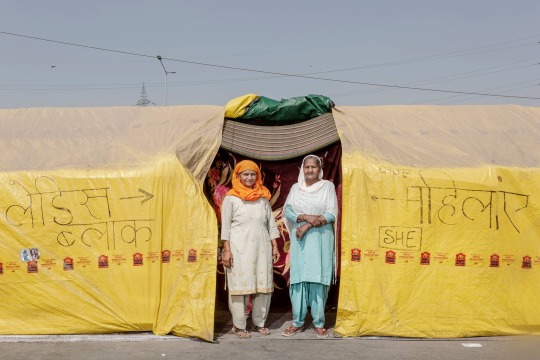
Sarjit Kaur, left, and Dilbeer Kaur, right, from Rampur, Uttar Pradesh, have been at the protests for two months. “We are here to show solidarity and support,” Dilbeer says. Prime Minister Modi is “making us leave our farms and sit here to fight for our rights. We are here to get these laws repealed, and we will be here till we get it done.” Kanishka Sonthalia for TIME
The U.N.’s Food and Agriculture Organization has urged action on the gender gap in agriculture, saying women’s voices must be “heard as equal partners” to ensure both agricultural development and food security. And at the protests in India, women are speaking up. Before now, some women had never stepped out of their homes without a veil, let alone spoken onstage in front of thousands of men. Many arrive at the sites in tractors, a powerful—and previously male—symbol of farming in India. “Women are changing women here,” Nat says, praising the spirit of protest among these women. “They are claiming their identities as farmers.”
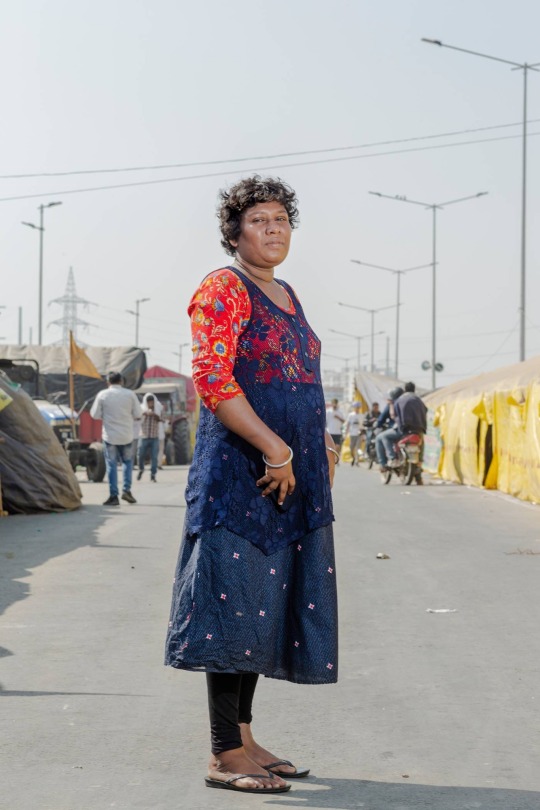
Bindu Ammini is a well-known Dalit rights and women’s rights activist from Kerala. “I came here to support the farmers” she says. “but I saw a very different India without any caste or gender discrimination. Hopefully it will continue beyond the protest.” Kanishka Sonthalia for TIME
All of this is happening in India’s deeply patriarchal heartlands of Uttar Pradesh, Punjab and Haryana. Changing mindsets in states where femicide, sexual violence and gender discrimination are rampant has been a persistent challenge for activists. “We have been working to bring about gender equality in these parts for so long—but the process has been slow,” says women’s rights activist Sudesh Goyat. During the first few days of protests in Tikri, she says, she was the only woman from Haryana there. But after the court suggested women leave, they “started to pour in. They came with their families. They came with other women. They came alone. It’s no less than a miracle,” she says.


Left: Urmila Devi, 41, works in the fields with her husband in Bahadurgarh village near the Tikri site. “Both of us get it done together. I don’t know about rights,” she says. “I have never thought about it too much. There’s a family to run and mouths to feed.” Kanishka Sonthalia for TIME
Right: Inspired by women singing, reciting protest poetry and chanting slogans at Tikri, 18-year-old farmers Sahumati Padha, left, and Hiraath Jhade came from the central state of Chhattisgarh. “I wanted to bring our story to them and to the rest of India,” Padha says. “We need to be seen.” Kanishka Sonthalia for TIME
It’s also a unique opportunity to address the gender imbalance in Indian society, says Gurnaam Singh, state secretary of the Punjab Kisan Union. At the protest sites, men and women from different cultures and communities must live side by side without much privacy and under harsh circumstances.
Taking advantage of this rare situation, activists hold frequent discussions on women’s work and their contribution to the rural economy. Regular announcements from the stage about treating women as equals echo around the protest sites throughout the day. “I like this India,” says Harsharan Kaur, a young IT engineer who left a job in Dubai to volunteer at the protest site.

A gender-rights activist from Haryana, Sudesh Goyat has been at the Tikri protest site since the very beginning, helping mobilize women and organize for Jan. 18 to be recognized as Women Farmers Day. “Women work equally in the fields with the men. It’s only right they should be here to protest,” she says. “The awareness among women about their own power has never been higher than now.” Kanishka Sonthalia for TIME
At the Ghazipur site, 29-year-old Ravneet Kaur, a law student from Bangalore, has successfully normalized conversations around a taboo topic in India: menstruation. She set up a women’s store at the site with the help of the women protestors, where they displayed sanitary napkins openly. “The men got used to it soon enough,” she says. “Now these conversations are normal around here. Men don’t flinch when they say sanitary napkins anymore.”
Whether such sentiments will spread beyond the protests is unclear, but for now, female farmers are being seen, heard and acknowledged—offering a new vision of what gender equality might look like for the country. “We have looked upon them as mothers, sisters, wives,” says Sukh Deep Singh, a young farmer from Punjab. “But now we see them in a different light.”
The women see themselves differently too. In Tikri, Sudesh Kandela, a 55-year-old farmer from Haryana, watches a play being staged by a local theater group, enraptured by the spectacle. “I didn’t know what I was capable of beyond the expectations of me as a woman, a wife and mother,” says Kandela, who had never before been to a protest or taken her veil off outside her home. “But I am here now,” she says, clenching her fists, “and I cannot be oppressed. I cannot be intimidated. I cannot be bought.”
3 notes
·
View notes
Photo
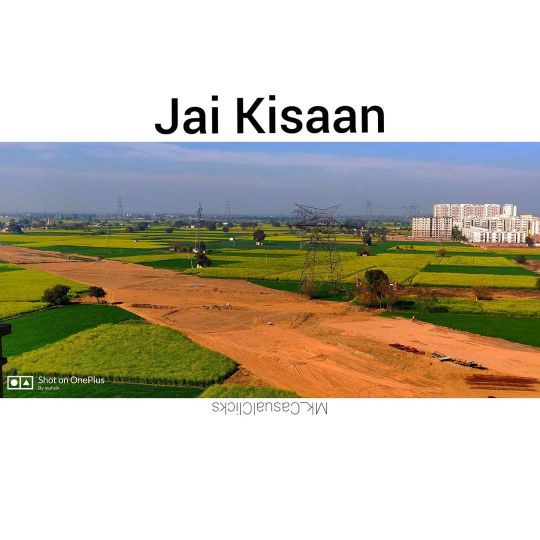
Jai Kisaan 🙏 #india #bhiwadi #haryana #rajasthan #gurgaon #landscapephotography #landscape #land #landscaping #farming #foodstagram #food #nature #farmer #naturephotography #naturelover #naturebeauty #beautiful #love #jaihind #mother #mothernature #instagram #instagood #shotononeplus #natgeoyourshot #mk_casualclicks #photographer #photographylovers #photo (at Bhiwadi, India) https://www.instagram.com/p/CDeOFnapnqy/?igshid=sr6t8npxik35
#india#bhiwadi#haryana#rajasthan#gurgaon#landscapephotography#landscape#land#landscaping#farming#foodstagram#food#nature#farmer#naturephotography#naturelover#naturebeauty#beautiful#love#jaihind#mother#mothernature#instagram#instagood#shotononeplus#natgeoyourshot#mk_casualclicks#photographer#photographylovers#photo
1 note
·
View note
Photo
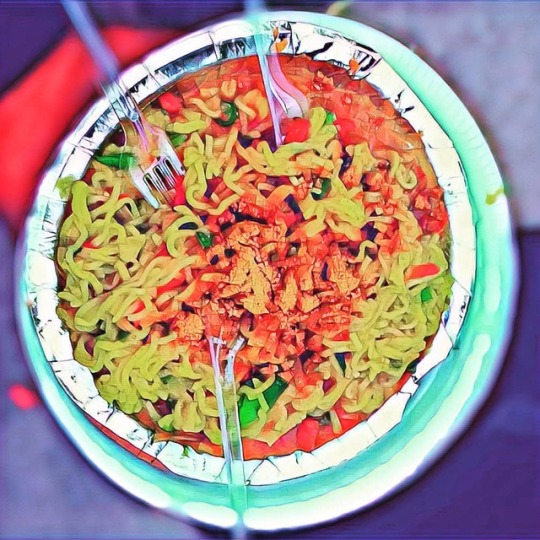
Office hunger killer #destino_2k #destino #photography #travelling #travelling #travelphotography #indianlocalguides #localguides #travels #travelblogger #travelholic #travelgram #traveller #travelersnotebook #photographer #photo #photooftheday #photographers_of_india #photographysouls #photoshoot #photobook #travelbook #foodporn #foodphotography #food #foodie #foods #foodstagram (at Gurgaon, Haryana) https://www.instagram.com/p/BtRERaihX6s/?utm_source=ig_tumblr_share&igshid=1sv90yl7f87it
#destino_2k#destino#photography#travelling#travelphotography#indianlocalguides#localguides#travels#travelblogger#travelholic#travelgram#traveller#travelersnotebook#photographer#photo#photooftheday#photographers_of_india#photographysouls#photoshoot#photobook#travelbook#foodporn#foodphotography#food#foodie#foods#foodstagram
1 note
·
View note
Text
Hire the Best Food Photographer in Your Budget in Rohtak, Haryana.

Do you want to hire a professional food photographer at an affordable price? Food photography is very important for increasing sales of a restaurant and shops, pictures of food are the most important thing. But why hire a food photographer when you can just rely on your smartphone for menu photography? Because the quality you need to sell more can only come from a professional photographer. Taking pictures of food is not as easy as it seems. Professional food photography brings a lot to the table, from expertise to talent and the artistic eye, among others. We have 10 years of experience in food and product photography, and thousands of customers trust us for our better work.
#Best food photographer in Rohtak Haryana#food photographer in Rohtak Haryana#food photographer in Rohtak#Food Photographer in Haryana#professional Food photographer in Rohtak#freelance food photographer#food photographer India#professional food photography
0 notes
Text
Name of Post:
Haryana HPSC HCS Civil Services Online Form 2023
Post Date:01 December 2023 @ 10:01PMShort Information :Haryana Public Service Commission (HPSC) has Recently Invited to the Online Application Form for the Post Civil Services Examination Recruitment 2023.
Haryana Public Service Commission (HPSC)
HPSC HCS Civil Services Recruitment 2023
Advt. No.58/2023
Important Dates
Start Date: 01/12/2023
Last Date : 21/12/2023
Pre Exam Date : 11 February 2024
Mains Exam Date : 30, 31 March 2023
Application Fee
General / EWS :Rs. 1000/-
SC/ BC/ ESM : Rs. 250/-
Haryana Female : Rs. 250/-
PH Candidates: Rs. 0/-
You can pay through:
Credit Card
Debit Card
Net Banking
UPI
Age Limit as on ( 01/01/2023)
Minimum. Age : 18 Yrs.
Maximum. Age : 27 Yrs. (DSP)
Maximum. Age : 42 Yrs. (Other)
Age Relaxation read the notification.
Eligibility Criteria
Bachelor Degree in Any Stream From Recognized University in India.
Vacancy Details
Total Post : 121 Post
Physical Eligibility ( DSP Post)
Sr.NoGenderHeightChestChest with Expansion01Male5'7" (170.18 cm)82.82 cm87.63 cm02Female5'2" (157.50 cm)N/AN/A
Selection Process
Preliminary Written Exam (200 Marks)– Qualifying
Mains Written Exam (600 Marks)
Personality Test/ Interview (75 Marks)
Document Verification
Medical Examination
HPSC Pre Exam : Offline
SubjectQuestionsMarksTimeGeneral Studies1001002 HoursCivil Services Aptitude Test (CSAT)- Qualifying1001002 Hours
HPSC Mains Exam Pattern : Descriptive
Paper No.SubjectMarksTimePaper-IEnglish (Including Essay)1003 HoursPaper-IIHindi (Including Essay)1003 HoursPaper-IIIGeneral Studies2003 HoursPaper-IVOptional Subject2003 HoursHPSC HCS Salary OverviewName of the PostsHCS Pay ScaleHCS Pay LevelHCS Grade payBasic SalaryIn-hand salary (Approx.)HCS Executive BranchINR 15,600 to INR 39,100FPL-10INR 5,400INR 56,100INR 69,000 to INR 75,000Deputy Superintendent of PoliceINR 9,300 to INR 34,800Level-9INR 5,400INR 53,100INR 66,000 to INR 71,000Excise and Taxation OfficerINR 9,300 to INR 34,800Level-9INR 5,400INR 53,100INR 66,000 to INR 71,000District Food & Supplies ControllerINR 9,300 to INR 34,800Level 9(1)INR 4,600INR 44,900INR 57,000 to INR 61,000'A' Class TehsildarINR 9,300 to INR 34,800Level 09INR 4,600INR 44,900INR 57,000 to INR 61, 000Assistant Registrar Cooperative SocietiesINR 9,300 to INR 4,800Level 09INR 4,600INR 44,900INR 57,000 to INR 61,000Assistant Excise and Taxation OfficerINR 9,300 to INR 34,800Level-7INR 4,600INR 44,900INR 57,000 to INR 61,000Block Development and Panchayat Officer (BDPO)INR 9,300 to INR 34,800FPL-7INR 4,600INR 44,900INR 57,000 to INR 61,000Traffic Manager (TM)INR 9,300 to INR 34,800FPL-7 (I)INR 4,600INR 44,900INR 57,000 to INR 61,000District Food & Supplies Officer (DFSO)INR 9,300 to INR 34,800FPL-7 (I)INR 4,600INR 44,900INR 57,000 to INR 61,000Assistant Employment Officer or AEOINR 9,300 to INR 34,800FPL-7 (I)INR 4,600INR 44,900INR 57,000 to INR 61,000
Required Documents
Candidates Photograph
Candidates signature
How To Apply
These are following step.
Click on the Apply Online Link given below.
Fill out the application form.
Upload the required documents
Pay Fees
Print the Application Form.
Details..
0 notes
Text
How to Make Haryana Ration Card Online
How to Make Haryana Ration Card Online
How to Make Haryana Ration Card Online : Food department has provided us both online and offline facility to make new ration card in Haryana In offline, we have to fill the prescribed application form and submit all the necessary documents. But through online facility, we can get Haryana ration card made sitting at home.
Haryana Ration Card online process
We must have a little knowledge about the Haryana Ration Card online process to make an online ration card. Because for this the online application form has to be filled and all the required documents have to be uploaded. But most of the people do not know about the Haryana Ration Card online process. So here we are telling step by step in an easy way how to make Haryana online ration card? So let’s get started.
Types of Ration Card in Haryana
* APL (Above Poverty Line)
* CBPL (Centre Below Poverty Line)
* AAY (Antyodaya Anna Yojana)
* OPH (Other Priority Household)
Documents Required to Apply for Haryana Ration Card
To apply for a ration card, you will have to submit the following documents:
* Recent passport size photograph
* Aadhaar card
* Gas connection
* Previous electricity bills
* PAN card
* Income certificate
* Caste certificate
* Bank passbook
How to make Haryana Ration Card Online?
* To make Haryana Ration Card Online, first you have to open the official website of your state’s Haryana SARAL portal.
* To go to the website of SARAL portal, search by typing SARAL portal and the name of your state in the Google search box. Like – SARAL portal Haryana.
* After opening the SARAL portal website, register or Login with your citizen ID and password.
* If you have not registered on the SARAL portal , then register first. Or you can login by asking for the username and password of any other person who has registered.
* After login on the website SARAL portal, click available services.
* In the provided menu, search for Ration Card. Food and Civil Supplies (Ration Card) has to be selected from the given service list.
* Now select the new entry or new application option under NFSA.
* After the application form for ration card is opened, first of all you have to fill the application number and certificate ID of your income certificate. Both of these will be found in your income certificate.
* The next step is to fill your area details. Then fill the details of the head of the family.
* Then the head, in whose name the ration card is to be made, has to fill the address details.
* In the next step, all the members in the family, whose Aadhaar card has been made, have to be added one by one.
* Now the bank account details have to be filled. Here enter the account holder name, account number and IFSC code.
* Now you have to upload the required documents. Such as – photo of the head, copy of bank passbook, copy of Aadhar card.
* After filling all the details and uploading the documents, select the Save button.
* As soon as your application is submitted, you will see the application number on the screen. Note it down carefully.
* Now go to the main menu and select the option to forward the application to the concerned authority.
* Then fill your application number in the prescribed box and forward it.
As soon as it is forwarded to the concerned officer, your ration card will be applied.
Note : If you do not have username and password to login to SARAL portal website, then you should visit any CSC center i.e. Customer Service Center . There all the details and documents will be asked from you. Then your Haryana Ration Card will be applied online. For this you will be charged applicable fees.
How to Make Haryana Ration Card Offline
Applicants may obtain the form from the nearest Public Distribution System (PDS) or from its official website Haryana Ration Card Form PDF can also be downloaded using the link given at the bottom of this page.
Details to be Mentioned in Haryana Ration Card Form: Name of the Head of the Household (Eldest Woman), Mother’s name, Father name, Spouse name, Address, FPS name & address, Type of ration card, details of gas connection, Family member details.
After carefully fill this form along with the necessary documents submit this form to the nearest Public Distribution System (PDS) department of the Haryana Government.
Haryana Ration Card Form – Apply Online
Applicants must visit the official website to apply for a new ration card, or it can directly click on this link – https://saralharyana.gov.in/New Ration Card
Where to find a Common Service Centre or CSC in Sonipat Haryana or a CSC Centre nearby?
Please visit Shahpur Turk CSC, Near Govt School, VPO Shahpur Turk, Sonipat to avail any e-governance service explained here along with Haryana Ration Card Online procedure.
* Insurance Motor, Insurance Health, Insurance Life, Insurance cattle, Insurance property, Insurance Fire, Insurance personal accident
* PAN Card application
* Passport Assistance Services
* E-Nagrik & E- District Services {Birth/ Death Certificate etc.}
* Pension Services
* NIELIT Services
* Aadhar Printing and Enrollment
* PAN Card
* Electoral Services
* Voter Card
* Ration Card
* E-Courts and Results Services
* State Electricity and Water Bill Collection Services
* IHHL Project of MoUD (Swachh Bharat)
* IRCTC, Air and Bus Ticket Services
* Mobile and DTH Recharge
* English Speaking Course
* Agriculture Kisan Services
* CSC Bazaar
* E-Learning
* digital work online
* Find Shahpur Turk CSC Sonipat Haryana
Find Shahpur Turk CSC Near Govt School Shahpur Turk Sonipat Haryana center
Find Shahpur Turk CSC Near Govt School Shahpur Turk Sonipat Haryana mobile number
Find Shahpur Turk CSC Near Govt School Shahpur Turk Sonipat Haryana number
Find Shahpur Turk CSC Near Govt School Shahpur Turk Sonipat Haryana office
Find Shahpur Turk CSC Near Govt School Shahpur Turk Sonipat Haryana portal
Find Shahpur Turk CSC Near Govt School Shahpur Turk Sonipat Haryana scheme
Find Shahpur Turk CSC Near Govt School Shahpur Turk Sonipat Haryana status
Find Shahpur Turk CSC Near Govt School Shahpur Turk Sonipat Haryana view
csc, shahpur turk csc, aeps, digipay, insurance, passport, pan card, ration card, voter card, death certificate, birth certificate, bill payment, mobile recharge, pension,
Shahpur Turk CSC, Near Govt School, VPO Shahpur Turk, Sonipat, Haryana, India provides following Services through its Common Service Centre:- Insurance Motor, Insurance Health, Insurance Life, Insurance cattle, Insurance property, Insurance Fire, Insurance personal accident, PAN Card, Passport Assistance Services, Premium Collection Services of Insurance Companies, Birth Death Certificates, Pension Services, Aadhar, voter card, ration card, IRCTC train / air / bus ticket booking, hotel booking.
http://dlvr.it/SFfpqd
from WordPress https://ift.tt/33J9aLZ
via IFTTT
0 notes
Text
Gurudwara Nirmal Kutiya Building, Karnal
Gurudwara Nirmal Kutiya Karnal, Haryana Building Photos, Indian Religious Architecture
Gurudwara Nirmal Kutiya, Karnal
16 July 2021
Design: Space Race Architects
Location: near District Court, National Highway 1, Sector 13, Karnal, Haryana, northern India
Gurudwara Nirmal Kutiya Building in Karnal, India
Gurudwara Nirmal Kutiya by Space Race Architects in India has won the WA Award, 34th Cycle for the realized category. The contemporary take of this Gurdwara creates its presence internationally and is visited by a good number of pilgrims having ardent faith in Sikhism from across the globe.
Anciently Sikhism, as a religion did not have any particular symbol of architecture in their spiritual structures like Gurdwara. For instance, where Guru Nanak Dev. Ji (The founder of Sikhism) was born, it was originally a residence and due to lack of knowledge and resources unluckily it couldn’t be restored and halls of Gurdwara came up with elements of architecture that were prevalent at that time mostly derived from Muslim and Persian architecture.
The land, upon which this Gurudwara is built was a graveyard anciently. The same came into notice as skeleton pieces were found while digging the foundation. Today, it plays a vital role in spiritual incarnation as the religious symbol resides here and a positive ambience is spread across. The firm did not charge a penny for designing this project as it was considered as a responsibility of giving back to the society.
Also, the construction activity was supported by Volunteers of nearby areas, who wanted to contribute and add value to the beginning of a new abode of God. It is the vision of the Principal Architect that- after a centenary, when visitors shall pay homage to this sacred place. The contemporary nature of the building and palatial interior design will take them down to the memory lane of the 21st-century architecture of a Gurdwara.
Contemporary elements of the building include cantilever slabs, linear block with travertine look – Vitrified Wall tiles cladding, and a large glass for transparency at the exterior façade. A skeleton Dome marks the pinnacle of the Gurdwara and solely depicts its presence from a distance. There is a splendid fountain erected outside the main entrance directly aligned with the dome above.
A water source is prevalent on both the ends of the sanctuary to witness its reflection and create a sensory vibration for the visitors. One can see the refraction of a floating ‘Nishan Sahib’ (Sacred symbol at the top of a flagpole) with onyx light at the bottom. Further, the building cantilever playfully subtracts the flagpole to cross through it and can be related to the power of God. This flagpole truly depicts the contemporary element of Sikh Architecture being a symbol of triumph and unity.
On a more holistic note, there is a provision of a free kitchen as well. It plays a vital role in Sikhism. It is a common saying that “one can worship well, when one’s stomach is full”. For consuming Langar (food) everybody sits down on the same level which somehow also hints at the ideology that ‘all humans are equal in front of the almighty’. Also, there are window openings created from three sides to invite everybody irrespective of caste, creed, and color.
The interior of the building is beautifully canvased with chandeliers, blind pointed arches at the rear wall, floral-patterned carpet floors, and shades of beige at the embellishments. There is also an opulent use of the diffused sunlight from the east direction that adds spiritual ambience with the interplay of light and shadow. The arches are lifted from the old Gurdwara structures to get a reminiscence of the antique while giving a new touch. In this hall, the arches also have storage, so that the speakers and other instruments can be stored behind them.
Gurudwara Nirmal Kutiya Karnal, Haryana – Building Information
Project Name: ‘Gurudwara Nirmal Kutiya’
Architecture Firm: Space Race Architects, Jalandhar
Project Year: 2015-2018
Site Area: 6160 sqm (1.5 acres)
Built-Up Area of the hall: 292 sqm
The covered area including projections: 439 sqm
Design Team: Ar. Thakur Udayveer Singh and Ritika Singh
About the Writer – Pappal Suneja is a Design Researcher and an architect based in India & Germany. He is the founder & Curator of the Architectural Journalism & Criticism Organisation and currently pursuing Doctorate of Philosophy (Dr. Ing) under Professorship of ‘History & theory of Modern Architecture’ from Bauhaus University Weimar, Germany.
Gurudwara Nirmal Kutiya Building, Karnal images / information received 160721 from Space Race Architects
Address: Near District Court, National Highway 1, Sector 13, Karnal, Haryana 132001, India
Phone: +91 184 220 2707
Indian Architecture
Indian Architecture Designs – chronological list
Indian Architecture News
Indian Architect – design firm listings on e-architect
Indian Houses
Contemporary Buildings in India
Architecture competition Siemens Healthineers Campus, Bengaluru
Design: Eller + Eller Architects – 1st prize
image courtesy of architects practice
Siemens Healthineers Campus Bengaluru Competition
La Midas Wellness Centre, Gurgaon, New Delhi
Architects: Creative Designer Architects
photo Courtesy architecture office
La Midas Wellness Centre
New Buildings in India
The Cantilever House, Ghaziabad, Uttar Pradesh, northern India
Design: ZED Lab Architects, Delhi
photo Courtesy architecture office
The Cantilever House, Ghaziabad
18 Screens House
Design: Sanjay Puri Architects
photograph : Dinesh Mehta
18 Screens House in Lucknow
Comments / photos for the Gurudwara Nirmal Kutiya Building, Karnal design by Space Race Architects page welcome
The post Gurudwara Nirmal Kutiya Building, Karnal appeared first on e-architect.
0 notes
Link
https://ift.tt/2V1m1or
Editor's Note: In the run-up to World Population Day on 11 July, 2021, a six-part series on awareness regarding women’s and girls’ needs for sexual and reproductive health in different parts of the country will focus on the vulnerabilities during the pandemic. This is the first part of the series.
***
It’s 10:30 on a Sunday morning and Honey is getting ready for work. Standing in front of a dressing table, she carefully applies scarlet lipstick. “This will match well with my suit,” she says, as she rushes to feed her seven-year-old daughter. On the dressing table are slung a handful of masks and a pair of earphones. Cosmetics and make-up items lie unarranged on the table-top, while the mirror reflects photographs of gods and relatives hung in one corner of the room.
Honey (name changed) is getting ready to meet a client in a hotel some 7-8 kilometres from her home – a one-room set in a basti in New Delhi’s Mangolpuri locality. She is around 32 years old and a sex worker by profession, working in the nearby Nangloi Jat area of the capital. She is originally from rural Haryana. “I came 10 years ago and now I belong here. But my life has been a series of misfortunes since coming to Delhi.”
What sort of misfortunes?
“Four miscarriages toh bahut badi baat hai [are a very big thing]! They were for me, when I had no one to feed me, look after me and take me to a hospital,” says Honey with a smirk, signalling that she has come a long way on her own.
“This was the only reason why I had to take up this work. I had no money to eat and feed my child, who was still inside me. I had conceived for the fifth time. My husband had left me while I was just two months pregnant. Following a series of incidents arising from my illness, my boss threw me out of the factory I worked in, which made plastic containers. I used to earn Rs 10,000 a month there,” she says.
Honey’s parents married her off at age 16 in Haryana. She and her husband remained there a few years – with him working as a driver. They moved to Delhi when she was around 22. But once there, her alcoholic husband kept disappearing often. “He would be gone for months. Where? I don’t know. He still does that and never tells. Just moves away with other women and returns only when he is out of money. He works as a food service delivery agent and spends mostly on himself. That was the main reason I had four miscarriages. He would just not bring me any medicines that I needed, nor nutritious food. I used to feel very weak,” she adds.
Now Honey lives with her daughter in their home in Mangolpuri, for which she pays a rent of Rs. 3,500 a month. Her husband stays with them, but still does his vanishing act every few months. “I tried to survive after losing my job, but just couldn’t. Then Geeta didi told me about sex work and got me my first client. I was five months pregnant – and around 25 years old when I began this work,” she says. She continues to feed her daughter while we talk. Honey’s child studies in Class 2 of a private English-medium school that charges Rs 600 a month as fees. In the lockdown era, the child attends her classes online, on Honey’s phone. The same one on which her clients contact her.
“Sex work got me enough to pay for the rent and buy food and medicines. I made around Rs 50,000 a month in the initial period. I was young and beautiful back then. Now I have gained weight,” says Honey, bursting into laughter. “I had thought that I would quit this work after my delivery and look for decent employment, even as a kaamwali (domestic worker) or sweeper. But destiny had other plans for me.
“I was very eager to earn even during my pregnancy because I did not want a fifth miscarriage. I wanted to give the best possible medication and nutrition to my coming child, which is why I accepted clients even in my ninth month of pregnancy. It used to be very painful but I had no other choice. Little did I know this would lead to new complications in my delivery,” says Honey.
"Being sexually active in the last trimester of pregnancy can be hazardous in many ways,” Dr Neelam Singh, a Lucknow-based gynaecologist, told PARI. “She could experience a rupture of the membrane and suffer by contracting a sexually transmitted disease. She might undergo premature labour and the child could also get an STD. And if sexual intercourse often happens in early pregnancy, it could lead to abortion. Most times, women in sex work avoid carrying a child. But if they get pregnant, they continue to work, which could sometimes lead to late and unsafe abortion, risking their reproductive health."
“Once when I went in for a sonography, following unbearable itching and pain,” says Honey, “I got to know that I had an unusual allergy on my thighs, lower abdomen and swelling on the vagina. I felt like killing myself with all that pain and the expenses I knew would follow.” The doctor told her it was a sexually transmitted disease. “But then, one of my clients gave me emotional as well as financial support. I never told the doctor about my profession. That might have been inviting a problem. If she had asked to meet my husband, I would have taken one of my clients to her.
“Thanks to that man, I and my daughter are okay today. He paid half of the bills during my treatment. That is when I decided I could continue with this work,” says Honey.
“Many organisations tell them about the importance of using condoms,” says Kiran Deshmukh, coordinator of the National Network of Sex Workers (NNSW). “However, among sex worker women, abortions are more common than miscarriages. But generally, they go to the government hospital where the doctors also neglect them once they get to know of their profession.”
How do the doctors find out?
“They are gynaecologists,” points out Deshmukh, who is also president of the Veshya Anyay Mukti Parishad (VAMP), based in Sangli, Maharashtra. “Once they ask for their address and learn which locality the women are from, they would figure it out. The women are then given dates [for abortion] that often get postponed. And many a time, the doctor eventually declares that abortion is not possible, saying: ‘you have exceeded four months [of pregnancy] and now it would be illegal to abort’.”
Quite a few of the women simply avoid seeking some kinds of medical help at government hospitals. According to a 2007 report from the United Nations Development Programme's Trafficking and HIV/AIDS project, almost “50 per cent of sex workers [surveyed across nine states] reported not seeking services like ante-natal care and institutional delivery from the public health facilities.” Fear of stigma, attitudes, and urgency in the case of deliveries, seem to be among the reasons for that.
“This profession is directly related to reproductive health,” says Ajeet Singh, founder and director of Gudiya Sanstha, a Varanasi-based organisation that has combated sex trafficking for over 25 years. Singh, who has also worked with organisations helping women in Delhi’s GB Road locality, says that in his experience “75-80 per cent of women in sex work have some or the other reproductive health issues.”
“We have all kind of clients,” says Honey, back in Nangloi Jat. “From MBBS doctors to policemen, students to rickshaw pullers, they all come to us. When younger, we only go with people who pay well, but as our age increases, we stop being choosy. In fact, we need to stay on good terms with these doctors and policemen. You never know when you might need them.”
How much does she earn in a month now?
“If we exclude this lockdown period, I was making around Rs 25,000 a month. But that is an approximate number. Payments differ from client to client, depending on their profession. It also depends on whether we spend the entire night, or just hours (with them),” says Honey. “If we have doubts about the client, we don’t go to hotels with them and call them to our place instead. But in my case, I bring them here to Geeta didi’s
Geeta, who is in her early 40s, is the overseer of sex workers in her area. She is also in the deh vyapar (body business), but mainly makes her living by offering her place to other women and claiming a commission from them. “I bring needy women into this job and when they do not have a place to work, I offer them mine. I take only 50 percent of their income,” says Geeta simply.
“I have seen a lot in my life,” says Honey. “From working at a plastic factory and being thrown out because my husband left me, to now this fungal and vaginal infection I live with and still take medicines for. It seems destined to be with me forever.” These days, her husband is also living with Honey and their daughter.
Does he know about her profession?
“Very well,” says Honey. “He knows it all. Now he has an excuse to depend on me financially. In fact, today, he is going to drop me to the hotel. But my parents [they are a farming family] have no clue about it. And I would never want them to know. They are very old people, living in Haryana.”
“Under the Immoral Traffic (Prevention) Act, 1956, it is an offence for any person above the age of 18 to live off the earnings of a sex worker,” says Aarthi Pai, Pune-based legal adviser to both VAMP and NNSW. “That could include adult children, partner/husband and parents living with a woman in sex work and dependent on her earnings. Such an individual can be punished with imprisonment up to seven years.” But Honey is very unlikely to act against her husband.
“This is the first time I am going to meet any client after the lockdown ended. There have been few, almost none, these days,” she says. “Those who do come to us now, in this pandemic period, mostly can’t be trusted. Earlier, we only had to take precautions to stay clear of HIV and other [sexually transmitted] diseases. Now, there is this corona too. This entire lockdown has been a curse for us. No earnings at all – and all our savings have gone. I could not even get my medicines [anti-fungal creams and lotions] for two months because we could barely afford the food to survive,” says Honey, as she calls out to her husband to bring out his motorbike and drop her at the hotel.
The author reports on public health and civil liberties through an independent journalism grant from the Thakur Family Foundation.
This article was originally published in the People's Archive of Rural India.
Originally posted here: https://ift.tt/3qGMhjs
0 notes
Text
Central University of Haryana Jobs 2021 – Biotech & Food Sciences JRF
New Post has been published on https://biotechtimes.org/2021/03/05/central-university-of-haryana-jobs-2021-biotech-food-sciences-jrf/
Central University of Haryana Jobs 2021 – Biotech & Food Sciences JRF
Central University of Haryana Jobs 2021
Central University of Haryana Jobs 2021 – Biotech & Food Sciences JRF. Central University of Haryana is looking for a Food Technology & Science / Biotechnology candidate for the Research Fellow vacancy. Interested candidates can check out the details below:
Biotechnology & Food Sciences JRF
Applications are invited on plain paper along with a detailed CV for one post of Junior Research Fellow in DST (International Multilateral and Regional Cooperation Division) sponsored project entitled “Dietary fibers from underutilized crops and agro wastes for application in food and feed”, purely on a temporary basis. The details of the post are as follows:
Name of the Post: Junior Research Fellow (01)
Tenure of the post: Upto Two years (subject to the satisfactory performance of the candidate)
Fellowship amount: Rs 31,000/- per month + HRA (As per norms of funding agency)
Essential Qualifications: Post Graduate (M.Sc.) in Microbiology/ Biochemistry/ Biotechnology/ Molecular Biology/ Life sciences/ Food Sciences & Technology with atleast 60% marks (or equivalent) OR Post graduate inprofessional course (M.Tech. / M.Sc. Ag) in allied areas with at least 60% marks (or equivalent)
Desirable Qualification: Relevant Research experience and/ NET/ GATE qualifications
How to apply: Candidates fulfilling above requirements must essentially bring:
• Their CV mentioning: full details of academic qualifications, research experiences, telephone/mobile number, email address, names and contact details of references familiar with candidate’s qualifications and achievements etc.
• Attested copies as well as original copies of relevant documents and
• Passport size photograph at the time of interview.
Eligible and interested candidates may send their CV through email to [email protected]
Date & Venue of walk-in-interview: 25th March 2021 (reporting time: upto 11 am) at Department of Microbiology, Central University of Haryana, Jant-Pali, Mahendergarh, Haryana-123031.
Note:
The above post is purely temporary for sanctioned projects and duration.
No T.A/D.A or any other allowances will be paid for attending the interview.
Fellowship may be canceled at any time in case of any misconduct, unsatisfactory research work, or if the fellow is found ineligible later.
The rules and regulations of CUH and/or the funding agency (AISTDF-DST) will be applicable on the selected candidate
Correspondence: Dr. Gunjan Goel (Principal Investigator), Associate Professor, Department of Microbiology, Central University of Haryana, Mahendergarh, Haryana 123031
Download Notification
#Biochemistry#Biotechnology#Food Technology Jobs#Jobs#Life Sciences#Microbiology Jobs#Molecular Biology
0 notes
Text
How to book a Covid-19 vaccine dose
Covid-19 vaccine registration: the second spherical is below way, and is open to particular categories of the overall populace. who're eligible, and who aren't? A take a look at the standards, and methods for registration and appointment
For the first time considering India started its vaccination programme towards Covid-19 on January sixteen, the general population will be eligible for the vaccine within the second section that started out on Monday. it's miles for those above age 60, and those above 45 with co-morbidities. Hindi News

On the primary day, 25 lakh capability beneficiaries registered at the Co-win portal and could be vaccinated within the following couple of days.
Covid-19 vaccination: what's specific approximately the second section?
As within the first phase, the vaccine kind will not be disclosed to the beneficiary on the time of appointment. A beneficiary can self-register themselves and three others the usage of the identical cell range. Slots may be open from 9 am till three pm, and appointments may be booked any time earlier than 3 pm challenge to availability.
2d, the applicant can pick the vaccination centre, date, and time in any state. as an example, a person registered as a voter in Haryana can get vaccinated in Kerala.
0.33, until the time of vaccination, all information of registration and appointment may be edited or deleted with the aid of the applicant. only while a person gets vaccinated is the record locked and cannot be edited.
what's the manner for self-registration?
The beneficiary has to log in to cowin.gov.in and input a cell number; a one-time password is sent to the quantity. as soon as the OTP is proven, the beneficiary has to go into 4 info: the photograph id she intends to show at the time of vaccination; the picture identification range (as an example the Aadhaar wide variety if that is the id); age and gender; and whether the beneficiary is laid low with any pre-current co-morbidity.
After these are entered, the beneficiary will be requested to check in. once the registration is whole, she will be able to receive a message. She might be given an choice to register up to a few more folks, for each of whom she has to go into 3 info: photo id evidence; identification evidence wide variety; call, age, and gender. The applicant can have the option to delete a beneficiary before booking an appointment.
what is the technique for an appointment?
The beneficiary has to click on ‘schedule Appointment’, and the web page will direct her to ‘ebook appointment for vaccination’.
in the next step, she will must pick out the kingdom, district, block, and pin code from a dropdown. After these are chosen, the system will display a list of vaccination centres.
once the beneficiary selects the vaccination centre from these options, the system will display the dates and the wide variety of slots available on a specific day, with an extra option to test the following week’s slots.
And once the beneficiary clicks ‘e book’, an ‘Appointment affirmation’ web page may be displayed. inside the very last step, the beneficiary has to click on ‘verify’ after verifying the details; once showed, the affirmation page will claim ‘Appointment a hit’.
What identification documents may be used?
you could use your Aadhaar card/letter; electoral picture identification card; passport; driving licence; PAN card; NPR smart card; or pension record with photo. the ones above age forty five and with comorbidities will also have to convey the co-morbidity certificates signed with the aid of a registered scientific practitioner.
Can a beneficiary stroll in with out registration on Co-win?
yes. The states can have a particular wide variety of mobilisation slots. certain vaccination centres may have a stroll-in-facility: On-site registration, appointment, verification, and vaccination will all be on-website the same day. For this, there could be no want for pre-registering beneficiaries online.
what is the procedure for the second dose?
After the first dose, the beneficiary might be robotically given a scheduled appointment for the second dose at the equal centre. but, if the beneficiary has moved to any other town, the appointment may be rescheduled on the nearest vaccination centre in that city.
ought to the second dose be on Day 29?
This isn't obligatory. in step with a steering file given to the states, the second dose may be scheduled on the same centre on Day 29; but, the beneficiary will have the option to alternate the slot for the second dose to any day among the 29th and forty second days.
this selection will to be had on two situations: whilst the primary dose has already been administered, and in that case, only for such centres in which the vaccine type is similar to that for the primary dose.
What information should a beneficiary claim to the vaccinator?
The beneficiary need to mention if she ever has had a severe hypersensitivity (anaphylaxis) after any drug, food, any vaccine, or any substances of the Covid-19 vaccine. 2nd, the beneficiary has to say if she has a fever. most importantly, she has to mention if she has a bleeding disorder or is on a blood thinner. Fourth, she has to say if she is immunocompromised, or is on a medicine that affects the immune gadget. Hindi News
0 notes